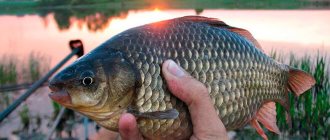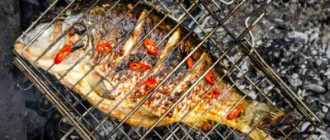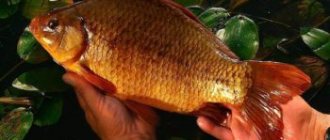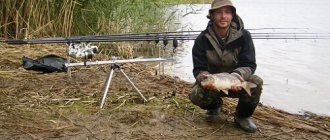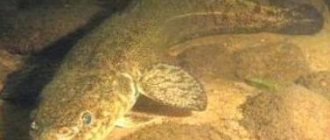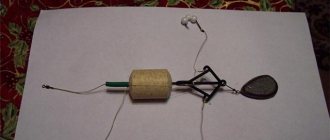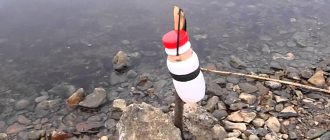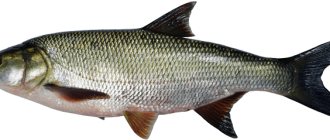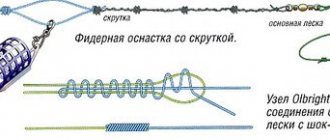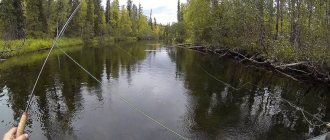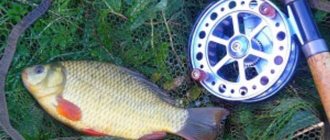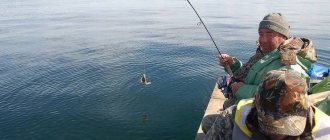Fishing for crucian carp in the spring is a very exciting activity that can be successfully carried out on various bodies of water. At this time of year, crucian carp can be very active; after the spawning period ends, they begin to eat. The time of increased activity of this fish falls on May and lasts until the second decade of June.
At this time, crucian carp is caught using almost all natural animal or plant baits known to the fisherman.
Bait for catching crucian carp
There are a huge number of bait mixtures for attaching crucian carp, which can be purchased at any fishing store, but if the bait is made independently, then, as practice shows, the catches of this fish increase several times when using a mixture prepared independently .
Bait recipes for crucian carp
The most common bait recipe for crucian carp consists of the following ingredients:
- Millet groats.
- Pearl barley.
- Semolina.
- Sunflower cake.
- Breadcrumbs.
Preparation of bait is carried out in the following sequence:
- In a saucepan with a volume of at least 3 liters, pour water to approximately 2/3 of the volume.
- The pan is placed on the fire and the water is brought to a boil.
- 200 grams of pearl barley are added to boiling water, and the porridge is cooked for 20 minutes.
- Then 200 grams of millet cereal is added to the pearl barley, and the mixture is cooked for another 30 minutes.
- After that, 100 grams of semolina are added and the mixture is cooked for another 10 minutes.
- Then remove the pan from the heat, add sunflower cake - 100 g and breadcrumbs - 100 g.
The mixture is thoroughly mixed and left to cool in the same container.
When preparing this bait, you should constantly stir the mixture. After the mixture boils, it is necessary to reduce the heat to prevent the porridge from burning. During the cooking process, you can add a small amount of water as needed.
To enhance the attracting effect, it is advisable to add natural dill juice to the bait, or flavor the porridge with vanilla - these smells usually attract this fish, regardless of the time of year.
Pea bait is no less popular for catching this fish.
The cooking process is carried out in the following sequence:
- 2 liters of water are poured into an enamel pan.
- Add 500 grams of peas.
- The peas are cooked for 1.5 hours over low heat.
- Peas are crushed using a potato masher.
The resulting pea puree can be flavored with unrefined sunflower oil or dill juice, but even if this is not done, the pea smell can attract crucian carp from a considerable distance.
The third method, but no less effective than those described above, is buckwheat porridge.
A very simple cooking method, which consists of simmering buckwheat in water over low heat for 40 minutes.
Porridge can be used in its pure form, but bait seasoned with unrefined sunflower oil usually gives better results.
Lure
In addition to the right location and equipment, the feeding system is, of course, very important in the tactics of crucian carp. In early spring, one bait is required, and after the bite becomes active, another is required. During the feeding season, you can catch crucian carp in the spring using a float rod without bait. However, most often feeding is still needed, especially closer to summer, when the bite gradually settles down.
At the beginning of spring we use poor, fine mixtures, with a weak natural aroma, dark in color - like in winter. In April-May, porridges begin to work - the mixture is made on the basis of a dry base, store-bought or homemade, with the addition of boiled millet, pearl barley or peas. It would be useful to add chopped worms to the bait due to the active bite of crucian carp.
Fine grinding for early spring without feed particles (feeder)
If it is possible to constantly visit a body of water, but the place is unknown to anyone else, it makes sense to use bait. To do this, you can pour 2-5 kilograms of boiled millet, corn, wheat, pearl barley with cake and breadcrumbs onto the point every 2-3 days. In warm water, bait for crucian carp in the spring on a fishing rod is always needed - we experiment with compositions and aromatics.
Read more about feeding crucian carp
Feed fraction
Features of feeding crucian carp
If it is possible to feed the fishing spot for several days, then this is the most effective way to attract crucian carp using bait mixtures. This method works well in reservoirs where there is almost no current.
The main thing, when carrying out baiting activities, is to correctly calculate the amount of bait that will be completely absorbed by the underwater inhabitants. Otherwise, you can get the opposite effect due to rotting of the remaining food in this area of the reservoir.
In the event that it is not possible to feed the fish in advance, this is done 30 minutes before the start of fishing. To do this, you need to form balls from bait and soil, which is taken directly from the reservoir in which you plan to catch crucian carp.
If the bottom is sandy , then you need to stock up on clay soil in advance, which will be used as a binding material in order to form balls of the required diameter.
The resulting bait balls are thrown to the place where the fish are supposed to be located. Due to the fact that they contain soil, which will be slowly eroded by water, gradually releasing bait that attracts crucian carp to the fishing spot.
If fishing is carried out on the current, then for bait you use a feeder with a load, which is attached with a thick fishing line or rope to some stationary object on the shore, and is thrown into the water, as close as possible to the underwater residence of the crucian carp.
Catching crucian carp in May with a float rod
At this time, the most promising tackle for catching crucian carp is a float rod. Fishing with a float rod is effective both in still water of lakes or ponds, and in the current.
The only difference is in the larger weight of the gear and a slightly different shape of the float , which is fixed only in the lower part when crucian carp fishing is carried out on the river. Previously, we talked about an effective tackle - a crucian carp killer.
Where to catch crucian carp in May with a float rod?
Crucian carp is the most common fish in Russia. In almost any body of water you can catch crucian carp using a float rod or bottom tackle. This fish especially likes areas of the reservoir rich in underwater vegetation.
If you plan to catch this fish on the current, then in those places where there is a reverse movement of the water mass there is a very high probability of encountering a huge number of large and small crucian carp.
Float rod, tackle, bait for catching crucian carp in May
The fishing rod used at this time is equipped with a small hook that will not scare away the fish. The fishing line is also selected according to this principle of maximum secrecy, and monofilament in this case copes with this task quite well.
The size and shape of the float depends on the fishing conditions . If the current on the river is too strong, then this part should be massive enough so that the movement of water does not drag the float.
It is better to use a fiberglass rod; if there is a chance of a giant crucian carp biting, then you should play it safe and buy a stick made of composite material.
Catching crucian carp in May using maggots
Crucian carp is caught very well with maggots. Due to the fact that this larva makes movements that attract fish for a long time, maggots must be present among the bait for catching crucian carp.
The maggot should be planted across the hook; you can use several larvae planted on one hook . In this case, bites from large fish are possible, which cannot always be tempted by one larva.
There are two varieties of maggots: white and red. The latter attracts crucian carp much more effectively. For catching this fish in May, this bait is the most catchy.
Catching crucian carp with burdock moth larva
This bait is slightly inferior in catchability to maggots and bloodworms, but due to the fact that it is quite easy to obtain it yourself even in the vicinity of a reservoir, it allows the fisherman, in cases where the supply of bait runs out, to replenish the supply.
When fishing with this bait, there are slight difficulties with attaching it to the hook. The larva of the burdock moth is very delicate and, if used ineptly, is easily torn. If this larva is prepared in advance, then it must be doused with boiling water to give it hardness.
After this procedure, the larva can be stored in the refrigerator for up to 2 weeks . When catching crucian carp with burdock moth larvae, small, sharp hooks are used.
The thickness should be minimal in order to penetrate through the larva without serious damage. As when fishing with bloodworms, this bait is used several times on one hook.
Catching crucian carp with a fly and grasshopper
Catching this fish using various insects in the month of May is always successful. It is enough to catch a housefly, place it on a small sharp hook on a thin line without a sinker, and throw such bait, and the crucian carp will not take long to bite.
The big disadvantage of this method of catching crucian carp in May is the presence of food competitors that feed at the surface of the water, for example, high water.
Grasshopper is also a favorite delicacy of this fish. Catching crucian carp using bark beetle larva is effective at this time of year.
Catching large crucian carp on a donk in spring
With the onset of spring, whole schools of crucian carp move from wintering pits to ponds, lakes and rivers. It is in early March that anglers manage to catch large crucian carp, the weight of which often exceeds 1 kg. It is best to look for fish near various anomalies on the bottom, or near various kinds of obstacles, in front of which the crucian carp often stops.
Catching crucian carp on a donk in the spring involves using delicate equipment with thin leashes, the thickness of which rarely exceeds 0.15 mm, and the diameter of the main line is about 0.2 mm. By the way, it is very often caught with a bottom rig, but with an elastic band. The length of the leashes is selected based on the fishing conditions and the equipment used; most often it is best to use leashes 50-70 cm long.
As for choosing a hook, I don't really focus on it. The main thing is that it is sharp and not rusty, of course. I often hear from fishermen that hooks for crucian carp should be made of thin wire, up to 0.3 mm in diameter.
It is interesting that crucian carp are best caught before spring spawning, about two weeks, after which they go to spawn. But this fish has one peculiarity - it spawns at different times, and you can catch crucian carp with or without caviar. Thus, the pre-spawning bite is lubricated and lasts more than two weeks.
Now let's talk a little about bait for catching large crucian carp on the bottom. I use bait according to my own recipe:
- 2 cups breadcrumbs;
- 4 cups ground flour (sunflower cake);
- 2 cups whole rolled oats;
- 1 glass of ground rolled oats;
- 1 cup roasted ground peanuts;
- 1 cup chopped worms.
All this is mixed and water is added. Water must be added until you achieve the desired consistency, which again is individual for each body of water and depends on the speed of the flow and the nature of the bottom. Well, a traditional video about feeder fishing for crucian carp in the spring:
Catching crucian carp in May using vegetable baits
No less effective, you can catch crucian carp in May using plant baits. Canned corn is one of the baits of choice this time of year. If you plan to catch a large fish, you should use a large hook with several corn kernels attached to it.
Semolina porridge, which after cooling is cut into small cubes, is an equally catchy bait. In order to increase the number of bites, artificial or natural flavors are added to this bait at the last stage of preparation.
Pearl barley, which is not cooked until fully cooked, is a good vegetable bait for catching crucian carp. Small crucian carp are usually caught using pearl barley. In order for fishing to be most effective, a small, sharp hook and thin, high-quality fishing line with a diameter of up to 0.25 mm are used.
This fish also bites very well on bread; for this, a ball is rolled out of the crumb of white bread, placed on a hook, and then the hook is dipped in unrefined sunflower oil. This method is effective only in reservoirs where there is no current and there is no need to make long casts of bait.
Potatoes occupy one of the places of honor among plant baits for catching crucian carp in May. To properly prepare potato bait, you should boil it in slightly salted water. There is no need to peel the potatoes; they need to be cooked until partially cooked.
Already upon arrival at the crucian carp fishing site in May, the potatoes are peeled and cut into cubes of a size that will best match the size of the hook.
Fishing for crucian carp with dough can bring big catches only if this bait is properly prepared.
The simplest way to prepare dough is to knead wheat flour with water taken from a reservoir where fishing takes place. If you add artificial or natural flavoring while kneading such dough, then the crucian carp will never ignore such a nozzle.
If the dough is made at home, then a chicken egg can be added to the dough. Then form small balls and boil them in water. It is important not to overcook the dough and when the balls float to the surface of the boiling water, take them out and cool.
Even more appetizing for crucian carp will be dough that has been lightly fried in unrefined sunflower oil. In this case, small balls are also formed from the dough, which are fried until golden brown.
Catching crucian carp in spring using a jig with a nod
Fishing for crucian carp in the spring with a nod is especially interesting, since the fish is very careful and requires people to have a certain approach, knowledge of the secrets and subtleties of fishing. I’ll tell you the first secret: it’s best to use bloodworms as bait in the spring, since the fish have not yet fully activated after wintering and prefer bait of animal origin.
They catch crucian carp in the spring both with a feeder and with a donk, but fishing with a nod shows the best results. The fact is that when using a jig, bites from small fish are automatically cut off. Most often only large crucian carp bite on a jig. And here the fishermen have additional excitement, they master the technique of fishing with new gear, and even only large fish bite.
Successful catching of crucian carp in the spring with a jig largely depends on the silence at the fishing site. Although there are rumors about crucian carp that it can handle anything, these are just rumors; if there is noise, it is afraid and swims away. If you managed to get to the fishing spot quietly and without spooking the fish, then that’s half the battle.
Otherwise, success in fishing depends on playing with a jig, which we’ll talk about next. First, throw the tackle into the water and let the jig reach the bottom. It is precisely at this time that you need to watch the nod very carefully. Very often, during natural deepening, crucian carp clings to the jig.
If this does not happen, then you need to carefully and smoothly lift the jig. This should be done very slowly, at about 1 cm/s, with pauses every 10-15 cm.
During the pause, you can make several short jerks, but do not get carried away, do everything smoothly and carefully. Do not make horizontal movements under any circumstances; not only will the fish not react to them, but it may even get scared.
Once you reach the surface, release the jig to the bottom again and repeat the process until you see the bend of the nod. If the nod is bent, you must hook it immediately, the main thing is to do it very gently so as not to tear the tender lips of the crucian carp. We recommend that you watch the video to fully understand everything.
Catching crucian carp in May with a sandwich
A sandwich is a bait that consists of several baits. Fishing for crucian carp with this bait is effective throughout the entire fishing season, including May.
You can combine baits on one hook as you like, but the most catchy ones are the following sandwich recipes:
- Bloodworms and maggots are an ideal combination for catching crucian carp with a float rod. The number of larvae used depends on the size of the hook, but usually it is 1 maggot, which is first strung on the hook and taken to the shank of the hook, then 2 - 3 bloodworms are placed on the hook.
- Dung worm and dough - such a sandwich consisting of bait of plant and animal origin can interest even a well-fed crucian carp. Swimming past a worm that seems to be eating a piece of dough, the crucian carp cannot resist swallowing such a successful combination of tasty food.
- Maggot and pearl barley - when fishing with such a sandwich, you can often catch large crucian carp, especially when using bottom gear. To successfully catch fish, use a small hook on which maggot and 2–3 grains of boiled pearl barley are strung.
How to choose gear for crucian carp in the spring?
The choice of the right tackle directly depends on a certain period of spring time, because at different times crucian carp behave differently. Do not forget that this is a very cautious and timid fish, which is why the choice of “hunting weapon” is so important.
Float rod
This type of gear is considered the best for spring fishing for representatives of the carp family. Since the fish is located close to the shore, choosing a float rod will be very useful.
This tool will allow you to easily get through the reed thickets and, carefully thrown, the bait will not allow you to scare away flocks of “cowardly hares”.
There are three types of float rods:
Plug
Using this gear, you can make a high-precision, quiet cast, without a splash of water that frightens the crucian carp, and place the bait right “under the nose” of the fish. During the early spring period, when the fish are not highly mobile, using a plug-in float rod will allow you to achieve excellent results.
A fisherman can expect a better bite if he uses:
- high quality rigid form;
- thin fishing line from 0.12 to 0.14 millimeters;
- float up to 0.7 grams;
- a hook of the appropriate size (the size of the hook depends on the size of the fish).
Match
With its help, you can easily cast bait over a long distance from the coast. The most important thing is the correct assembly of the gear. Match fishing has a certain rule - the longer the blank, the further the bait will be thrown.
This rule should not be forgotten when preparing for fishing. A reel on a match form must have a soft stroke and a reliable clutch. It is better to choose a fishing line that is dark, sinks quickly and has low memory.
Flywheel
This fishing rod does not have a reel and you cannot add extra line to it. It is designed for coastal fishing in small areas.
With a blank length of up to seven meters, you can fish directly from the shore without going into the water. But the best time to use a fly rod will only be early in the morning, before the crucian carp swims away from the shore following the warming water.
Feeder tackle
You can hunt a relative of carp using a feeder. Large individuals emerge from hibernation sluggishly, so they remain longer closer to the bottom surface, which are located at a considerable distance from the shore. But it is better to use feeder tackle towards the end of spring.
This time is due to the good heating of the water, which forces the fish to move to places where there are differences in depth. It would not be amiss to mention the use of feeder forms in time prior to spawning. It is before spawning that crucian carp becomes incredibly voracious.
To fish using a feeder you need to have two forms:
- The length of the rod is two and a half meters with an upper test limit of eighty grams. The spinning reel seat must be equipped with a braided cord with a diameter of 0.15 to 0.17 millimeters.
- A picker with a length of almost three meters (2.7) with an upper test limit of up to thirty grams, equipped with a monofilament line with a diameter of 0.16 to 0.18 millimeters.
Note! Any feeder chosen must be equipped with No. 10 or No. 12 hooks with a wide shank. And we must not forget about the feeder, which should be either an open light spring or mesh, weighing no more than thirty-five grams.
Rubber
With the first rays of the sun, the water surface is freed from its ice shell and begins to gradually warm up. And it is at this time that the crucian carp begins to move closer to warm areas.
At this time, it is better to start fishing for crucian carp with a “rubber band”, which works with rare casts, which does not scare the fish. You can use a larger number of hooks with a variety of baits, and it is convenient in windy weather.
This type of bottom gear consists of:
- cargo (weight from three hundred to four hundred grams);
- elastic bands (round cross-section with a diameter of three millimeters);
- main line (diameter 0.5 mm);
- working fishing line insert (diameter 0.3 mm);
- leashes and hooks (NoNo 6 and 7).
fishing line
Choosing a fishing line will not be difficult. This should definitely be a monofilament thread from 0.2 to 0.3 millimeters with a leash of 0.11 - 0.15 millimeters.
Hooks
Fishing classification of hooks is a rather controversial science and it differs for each manufacturer. You need to focus on hooks with numbers from six to fourteen.
Well, and there already, as they say, by scientific poking. The fisherman must determine for himself which hook will be the best option for fishing.
Tips from fishermen
The choice of fishing rod, in any case, remains with the fisherman, but the advice of “experienced” crucian carp hunters is worth listening to:
- blank material - carbon fiber or fiberglass;
- Form construction is fast;
- thread for the main line and leader - monofilament braided line with a diameter of up to 0.3 millimeters, leader - up to 0.14 millimeters;
- the number of weights on the float is at least two not very large, located close to each other;
- hooks - for small fish it is better to use No. 14, for larger specimens - No. 8.
